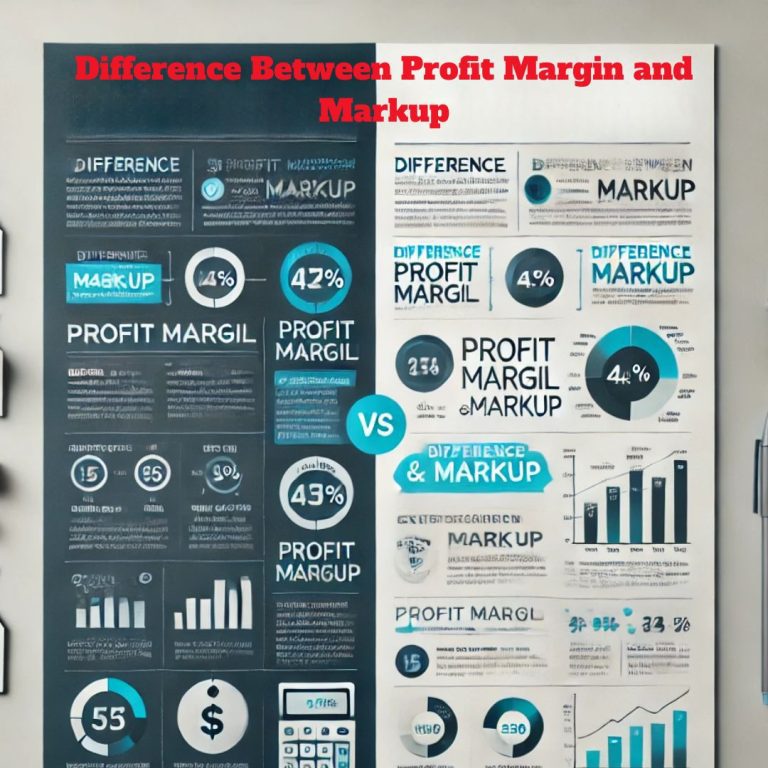The difference between profit margin and markup is crucial for business owners and managers when evaluating pricing strategies and profitability. Both terms relate to the profitability of a product or service, but they are calculated differently and used for distinct purposes. Profit margin is a percentage that reflects the overall profitability of a product after costs, while markup is the amount added to the cost of a product to determine its selling price. Understanding these differences is vital for making informed pricing decisions and managing business finances effectively.
Introduction: Understanding Profit Margin vs. Markup
When it comes to managing a business, two common metrics used to determine profitability are profit margin and markup. While both terms involve the relationship between cost and price, they are not interchangeable. Profit margin measures how much profit a business makes on its total sales relative to its costs, expressed as a percentage. Markup, on the other hand, refers to the amount added to the cost of an item to determine its selling price. Understanding the difference between profit margin and markup helps businesses in pricing, cost analysis, and ultimately, achieving the desired profitability.
What is Profit Margin? Key Concepts and Calculations
Profit margin is a profitability ratio that calculates the percentage of revenue that exceeds the cost of goods sold (COGS). It reflects how efficiently a company is managing its costs and turning revenue into actual profit. Profit margin can be calculated at different levels, such as gross profit margin, operating profit margin, and net profit margin, each providing insights into different aspects of a business’s financial health.
Types of Profit Margin
Gross Profit Margin: This represents the percentage of revenue remaining after subtracting the cost of goods sold. It focuses on the direct costs associated with producing goods or services.
Formula:
Operating Profit Margin: This margin measures profit after operating expenses, excluding interest and taxes.
Formula:
Net Profit Margin: This is the most comprehensive margin, showing the percentage of profit after all expenses, including operating costs, interest, taxes, and other non-operating items.
Formula:
Key Points on Profit Margin
- Profit Margin indicates profitability: It helps a business understand how much of its revenue turns into actual profit.
- Higher margin means better profitability: A higher profit margin typically indicates better management of costs and higher efficiency in generating profit.
- Commonly used for financial analysis: Investors and business analysts use profit margin to assess a company’s financial health and operational effectiveness.
Example
If a company has $100,000 in revenue and $60,000 in costs (COGS), the gross profit margin would be calculated as follows:
What is Markup? Key Concepts and Calculations
Markup refers to the amount added to the cost of a product or service to determine its selling price. Unlike profit margin, which is expressed as a percentage of revenue, markup is calculated as a percentage of the cost. Markup helps businesses set their prices based on the costs incurred to produce or acquire the product.
How to Calculate Markup?
Markup is typically expressed as a percentage over the cost of the product. The basic formula is:
Example of Markup Calculation:
If the cost of an item is $50, and the business wants a 40% markup, the selling price would be:
Key Points on Markup
- Markup ensures profitability: It helps businesses cover their costs and make a profit.
- Markup is cost-based: Unlike profit margin, which is based on revenue, markup is based on the cost of producing or purchasing a product.
- Determines pricing: Markup is directly tied to how much a business needs to charge over the cost to achieve desired profits.
Types of Markup
- Cost-Plus Pricing: This is the most common form of markup, where a fixed percentage is added to the cost of goods sold.
- Target Return Pricing: In this model, businesses set the markup based on achieving a specific return on investment (ROI).
Key Differences Between Profit Margin and Markup
Although both profit margin and markup are used to assess a business’s profitability, they have fundamental differences in their calculation and application:
| Aspect | Profit Margin | Markup |
| Definition | Percentage of revenue that turns into profit | Percentage added to cost to set price |
| Formula | Profit Margin = (Profit/Revenue) × 100 | Markup Percentage = (Selling Price – Cost) / Cost × 100 |
| Calculation Base | Based on revenue | Based on cost |
| Purpose | Measures overall profitability | Helps set the selling price |
| Perspective | Profit margin focuses on how much profit you make from revenue | Markup focuses on how much to add to cost to achieve desired profit |
| Usage | Used to assess a company’s financial health | Used for pricing decisions |
Key Takeaways
Profit margin reflects profitability in relation to total revenue, whereas markup focuses on the cost of the product.
Markup tends to be higher than profit margin because it’s based on cost rather than price.
Both markup and profit margin are essential for setting pricing strategies and evaluating financial performance but serve different purposes in the business analysis.
Conclusion
In conclusion, understanding the difference between profit margin and markup is essential for business owners, managers, and investors to make informed financial decisions. Profit margin provides a clear picture of how much profit a business generates from its total sales, while markup determines the price a business needs to charge over its costs to achieve desired profitability. Both metrics play a crucial role in pricing strategies and overall financial health, but they are used in different contexts and calculations. By mastering both, businesses can optimize their pricing strategy, improve profitability, and make better financial forecasts.
Difference Between Profit Margin and Markup FAQs
What is the main difference between profit margin and markup?
The main difference is that profit margin is calculated as a percentage of revenue, while markup is based on the cost of a product. Profit margin shows how much profit you make from your revenue, while markup determines how much to add to the cost to set a selling price.
How do you calculate markup?
Markup is calculated by taking the difference between the selling price and the cost, dividing it by the cost, and then multiplying by 100 to get the percentage. Formula: Markup Percentage=
Why is profit margin important for a business?
Profit margin is important because it helps a business understand how efficiently it is turning revenue into actual profit. A higher profit margin means the business is retaining more money from each sale after covering costs.
Can a business have a high markup but low profit margin?
Yes, it is possible. If the cost is very high, even a high markup percentage might not result in a high profit margin. Conversely, a low cost with a moderate markup could lead to a higher profit margin.
Is markup or profit margin more important for pricing decisions?
Both are important, but markup is directly used for pricing decisions as it determines how much to add to the cost. Profit margin is more about evaluating the overall profitability once the product is sold.


